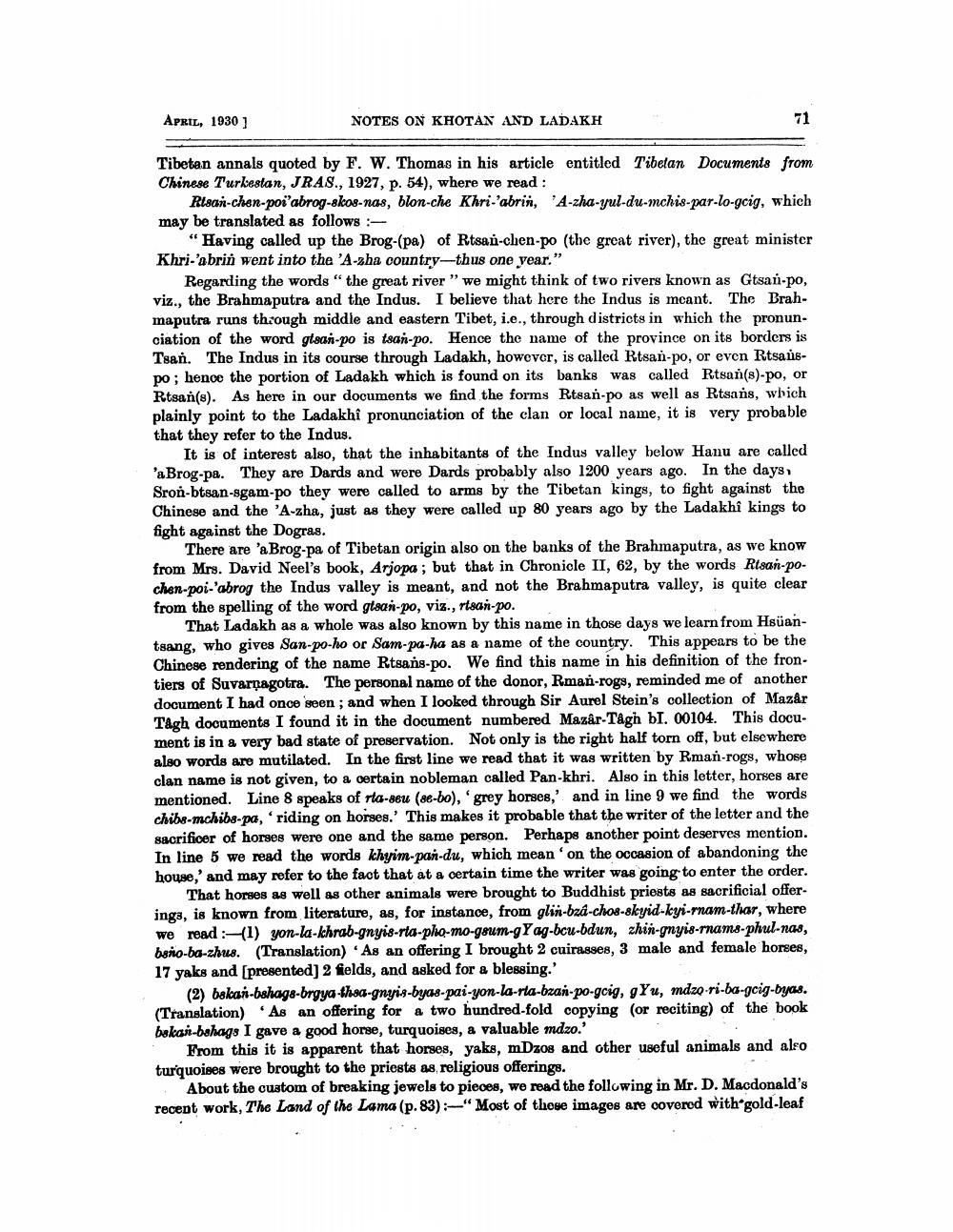________________
APRIL, 1930 ]
NOTES ON KHOTAN AND LADAKH
71
Tibetan annals quoted by F. W. Thomas in his article entitled Tibetan Documents from Chinese Turkestan, JRAS., 1927, p. 54), where we read:
Risan-chen-poi'abrog-skos-nas, blon-che Khri-'abrin, 'A-zha-yul-du-mchis-par-lo-gcig, which may be translated as follows:
"Having called up the Brog-(pa) of Rtsan-chen-po (the great river), the great minister Khri-'abrin went into the 'A-xha country-thus one year."
Regarding the words "the great river " we might think of two rivers known as Gtsan-po, viz., the Brahmaputra and the Indus. I believe that here the Indus is meant. The Brahmaputra runs through middle and eastern Tibet, i.e., through districts in which the pronunciation of the word gtsan-po is tsan-po. Hence the name of the province on its borders is Tsan. The Indus in its course through Ladakh, however, is called Rtsan-po, or even Rtsanspo; hence the portion of Ladakh which is found on its banks was called Rtsan(s)-po, or Rtsan(s). As here in our documents we find the forms Rtsan-po as well as Rtsans, which plainly point to the Ladakhi pronunciation of the clan or local name, it is very probable that they refer to the Indus.
It is of interest also, that the inhabitants of the Indus valley below Hanu are called 'aBrog-pa. They are Dards and were Dards probably also 1200 years ago. In the days) Sron-btsan-sgam-po they were called to arms by the Tibetan kings, to fight against the Chinese and the 'A-zha, just as they were called up 80 years ago by the Ladakhî kings to fight against the Dogras.
There are 'a Brog-pa of Tibetan origin also on the banks of the Brahmaputra, as we know from Mrs. David Neel's book, Arjopa ; but that in Chronicle II, 62, by the words Rtsan-pochen-poi-'abrog the Indus valley is meant, and not the Brahmaputra valley, is quite clear from the spelling of the word gisan-po, viz., risan-po.
That Ladakh as a whole was also known by this name in those days we learn from Hsüantsang, who gives San-poho or Sam-pa-ha as a name of the country. This appears to be the Chinese rendering of the name Rtsans-po. We find this name in his definition of the frontiers of Suvarnagotra. The personal name of the donor, Rman-rogs, reminded me of another document I had once seen; and when I looked through Sir Aurel Stein's collection of Mazár Tagh documents I found it in the document numbered Mazar-Tagh br. 00104. This document is in a very bad state of preservation. Not only is the right half torn off, but elsewhere also words are mutilated. In the first line we read that it was written by Rman-rogs, whose clan name is not given, to a certain nobleman called Pan-khri. Also in this letter, horses are mentioned. Line 8 speaks of ria-aou (88-bo), grey horses,' and in line 9 we find the words chibe-mchibs-pa, riding on horses.' This makes it probable that the writer of the letter and the sacrificer of horses were one and the same person. Perhaps another point deserves mention. In line 5 we read the words khyim-pan-du, which mean' on the occasion of abandoning the house,' and may refer to the fact that at a certain time the writer was going to enter the order.
That horses as well as other animals were brought to Buddhist priests as sacrificial offerings, is known from literature, as, for instance, from glin-bed-chos-skyid-kyi-ram-thar, where we read (1) yon-la-khrab-gnyis-rta-phuo-mo-gsum-gYag-bcu-bdun, zhin-gnyis-rnams-phul-nas, bero-ba-zhus. (Translation) As an offering I brought 2 cuirasses, 3 male and female horses, 17 yaks and presented) 2 fields, and asked for a blessing.'
(2) bekas-bshaga-brgya-thao-gnyis-byas-pai-yon-la-ria-bzan-po-gcig, gYu, mdzo-ri-ba-gcig-byas. (Translation) 'As an offering for a two hundred-fold copying (or reciting) of the book bekan-bahags I gave a good horse, turquoises, a valuable mdzo.'
From this it is apparent that horses, yaks, mDzos and other useful animals and also turquoises were brought to the priests as religious offerings.
About the custom of breaking jewels to pieces, we read the following in Mr. D. Macdonald's recent work, The Land of the Lama (p. 83) :-"Most of those images are covered with gold-leaf




